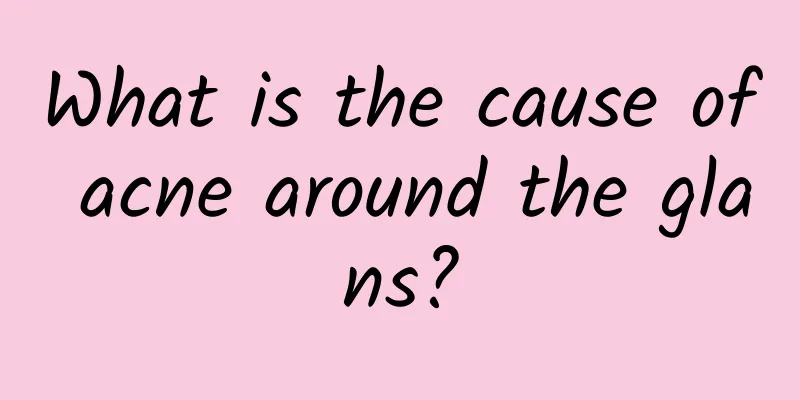What is the cause of acne around the glans?

|
Men's reproductive organs directly affect their future married life and the birth of children. If men can protect their reproductive organs, their future life will definitely be very smooth. However, some men in life are prone to some reproductive organ diseases because they do not keep themselves clean. For example, men who often go to nightclubs and have frequent sexual relations with others will find something like acne around their glans. What is this disease? Acne around the glans may be caused by genital herpes. Genital herpes (GH) is simple herpes that occurs in the genital area. It is a viral infectious skin disease and is classified as a fever in traditional Chinese medicine. It is different from simple herpes that occurs outside the corners of the mouth. Most cases are transmitted through sexual intercourse. 1. Symptoms HSV infection is a systemic disease. The virus enters the human body through the respiratory tract, oral cavity, genital mucosa or broken skin. It can lurk in normal mucosa, blood, saliva, local sensory ganglia and most organs. HSV can be isolated from almost all internal organs and mucosal epidermis. Primary infection is mostly latent, most of which are asymptomatic or present subclinical manifestations. Only a small number (about 1-10%) may show clinical symptoms, which are mainly seen in infants with low immune function or children with severe malnutrition or other infections. It is rare in adults. After the primary infection subsides, the virus can continue to reside latently in the body. About half of normal people are carriers of this virus and can become a source of infection through oral and nasal secretions. Since HSV does not produce permanent immunity in the human body, whenever the body's disease resistance is reduced, such as suffering from a certain febrile infectious disease, gastrointestinal dysfunction, menstruation, pregnancy, focal infection, excessive fatigue, and changes in emotional environment, the latent HSV in the body is stimulated and becomes ill. HSV-1 mainly causes oral herpes, pharyngitis, keratoconjunctivitis and sporadic encephalitis, while HSV-2 infection mainly causes genital herpes, but the opposite can also occur clinically. The incubation period of HSV infection is 1-45 days, with an average of 6 days. HSV-1 infection mainly occurs at the junction of the skin and mucous membranes such as the corners of the mouth, the edges of the lips, and the nostrils. It can also be seen on the face or lips. It starts with local burning and mild tension, occasionally accompanied by neuralgia, followed by erythema. Clustered small papules occur on the basis of the erythema, which quickly turn into millet- to mung-bean-sized blisters with clear contents. After the blisters rupture, erosive surfaces appear, which dry and form scabs after a few days. There is spontaneous burning, and occasional systemic symptoms such as fatigue, discomfort and mild fever. Temporary pigmentation may remain after healing. The whole course of the disease is about 1-2 weeks. HSV-2 infection mainly occurs in the genital area. The affected area first has a burning sensation, and soon groups of small blisters will develop on the basis of erythema. It is more common in the foreskin, glans penis, coronal sulcus, penis, etc. in men, and occasionally in the urethra; it is common in the labia, clitoris, vagina, cervix, etc. in women. The blisters can gradually turn into abscesses, which will rupture in about 6 days to form erosions or shallow ulcers, which are painful. Patients may develop urethritis and have difficulty urinating. Most people have enlarged and painful inguinal lymph nodes. Some patients may have fever, muscle pain and meningitis symptoms. If it occurs in the female cervix, it may form ulcers. Death, increased vaginal discharge, lower abdominal pain, attention should be paid to the occurrence of cervical cancer, genital herpes during pregnancy can easily lead to miscarriage, premature birth or stillbirth, and easily infect newborns, resulting in neonatal simple herpes. The disease can usually be cured after about 3 weeks, but there are often recurrent attacks, generally recurring within 1-4 months after the primary rash. The symptoms are milder than the primary one and the range is also smaller, limited to the genital area, sometimes only 1-2 herpes, and the course of the disease is also short, from onset to healing 8-12 days. The disease may also be accompanied by infections outside the genitals, such as the lips, arms and central nervous system. 2. Physical signs Skin lesions are erythematous with groups of blisters or pustules or erosions and ulcers on the base. About 90% of female patients have HSV cervicitis. The cervix may be red, eroded, ulcerated, and have purulent vaginal discharge. Some patients may have swollen and tender inguinal lymph nodes or fever. Skin lesions may also appear on the lips, fingers, buttocks, thighs, arms, and even the eyes and throat. Meningitis or transverse myelitis may occur. Neck stiffness and other symptoms of increased intracranial pressure usually occur 3-12 days after the onset of the rash. 3. Latent infection and recurrence About one week after HSV infects the human body, neutralizing antibodies appear in the blood, reaching a peak in 3-4 weeks and can last for many years. These antibodies can clear the virus and restore the body, but most individuals cannot completely eliminate the virus or prevent recurrence. The virus exists in the host body in a latent state for a long time. The clinical course of acute first-onset genital herpes in patients infected with different subtypes of HSV is similar, but the recurrence rate of genital lesions is different. About 90% of patients with first-onset HSV-2 infection will have a recurrence within 12 months (an average of 4 recurrences), while the first-onset HSV infection is less common. -1 only 50% of those with similar recurrences (the average number of recurrences is less than 1). The recurrence rate of genital HSV-2 infection varies greatly among different individuals and in the same patient's lifetime. Most patients relapse 5-9 times a year, usually within 1-4 months after the primary herpes disappears. Some patients relapse due to precipitating factors such as fever, menstruation, sun exposure, cold, and certain viral infections. The characteristic is that each recurrence often occurs in the same area, and there may be prodromal symptoms such as local itching before the recurrence, and burning and tingling in the infected area a few hours before the rash. Recurrent genital herpes (GH) has a great psychological impact on patients. Since there is currently no effective treatment to prevent recurrence and there is a risk of inducing genital malignancy, it brings psychological impact to patients. Most patients have psychological disorders such as depression and fear, which directly affect the recurrence of HSV. Our treatment experience shows that as long as patients adhere to regular treatment, they can be cured. 4. HSV and HIV infection: HSV often co-infects with HIV-1 and can promote the development of the disease, causing serious local and disseminated infections. It is currently believed that HSV is a regulatory factor that can activate HIV replication. Heng performed skin biopsies on 6 patients with AIDS and HSV skin damage in the reproductive system and found that keratinocytes and macrophages both had HIV-1 and HSV-1. After hybridization, HIV-1 retained its infectivity and could enter the cells without binding to CD4 molecules. In addition, HSV-1 can stimulate latent HIV-1, thereby increasing HIV-1/HSV-1 co-infection and replication in tissues. Epidermal cells undergo spheroidal degeneration, in which eosinophilic inclusion bodies can be seen. The epidermis initially forms multilocular blisters due to reticular degeneration, which later aggregate into unilocular blisters. The papillary dermis has mild edema and infiltration of inflammatory cells of varying severity. Severe vasculitis may occur when the reaction is severe. As a man, you should avoid unclean sex and improper sexual relations with multiple people. During the treatment period, do not have any sexual intercourse, and your spouse should also be examined. The reproductive organs should be cared for and kept dry and clean to prevent secondary infection. |
<<: Where is the best place for men to get hair transplant?
>>: What is the disease of the small fleshy granules under the glans?
Recommend
What happens if a man has kidney deficiency?
Kidney deficiency is what we often call kidney de...
What causes itchy and peeling scrotum?
In daily life, male friends will have some sexual...
What is the reason for the small red bumps on the penis
For male friends, the health of private parts is ...
Pictures of eczema acuminatum in men
In recent years, the incidence of genital warts h...
What to do if you ejaculate too quickly?
Sexual life is an indispensable behavior in our l...
How to treat urinary tract infection in men?
The temperature continues to rise, and the humidi...
How to treat cold air allergy?
Some people often develop allergies after using a...
Can I have a baby if I have cryptorchidism?
Cryptorchidism is a reproductive disease that is ...
What causes chest pain in men?
Generally, women may be more prone to chest pain,...
Which department is better for scrotitis?
If a man's scrotum becomes red, itchy, or has...
Can addiction be cured?
The male consciousness of adolescent boys is grad...
What is continuous ejaculation?
The so-called continuous ejaculation refers to ex...
Can long-term frequent masturbation be recovered?
Long-term and frequent masturbation of men can le...
How to treat kidney deficiency, yang deficiency and qi deficiency? Daily conditioning is the key
With the progress of society, many people pay mor...
Salt can reduce the sensitivity of the glans penis
Salt is an indispensable seasoning in our daily l...









